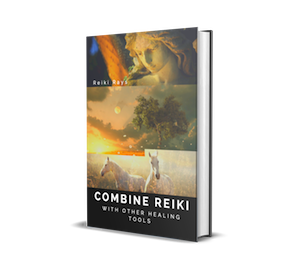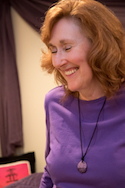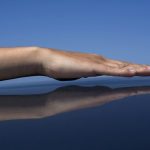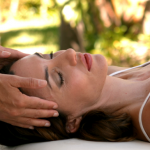Generally speaking, the treatment phase of the professional Reiki session begins with the energetic, or byosen scan, and is conducted when the client is comfortably situated on the Reiki table, and after the Pre-Session Intake and Discussion. Many Reiki practitioners recognize Byosen (“sick accumulation” or “place of sickness”) as a Japanese Reiki technique that identifies the areas most in need of healing and provides a baseline of energetic information for the practitioner as the treatment begins. Also, it creates a field of healing energy in the energetic body, enhancing the flow of Reiki throughout the treatment. The value of an intentionally conducted byosen scan cannot be underestimated; it provides a wealth of information about the recipient’s energy frequency in both the physical and subtle bodies. A thorough scan at the beginning, conducted at intervals throughout the treatment, informs the practitioner of the recipient’s response to Reiki’s healing energy as the treatment progresses, and is an indispensable tool.
I first learned of byosen, and its importance in a Reiki treatment, during my (first) Level 1 class many years ago. Our Reiki teacher emphasized the value of this technique, and strongly encouraged its use in all Reiki sessions. I took the advice to heart, and have incorporated byosen in all my Reiki sessions since then. Over the years, Reiki has guided me in using byosen, helping to refine it for optimal benefits. Its guidance is ever-evolving, and thus far, Reiki has helped me to develop a keenly focused intention for the scan, resulting in an increased perception of the individual’s energy field, and the areas most in need.
Learning the mechanics of the byosen scan is relatively easy and straightforward. However, it is a technique that requires practice and patience; these allow the practitioner to become increasingly perceptive over time to the energy emitted by the individual. With practice and patience, the practitioner becomes adept at identifying byosen in the physical and subtle bodies, as well as recognizing the response of these bodies to Reiki. As a result, learning and practicing byosen scanning truly becomes a necessary component of a complete Reiki session.
The Byosen Scan
To conduct a byosen scan, the practitioner assumes the Gassho position and silently sets an intention for the recipient’s deep healing and blessing. One may also activate Reiki symbols and invite the assistance of Beings in the highest heavens, if so guided. While standing at the person’s side as they lie comfortably on the Reiki table, and maintaining a relaxed yet focused intention, the practitioner places their non-dominant hand several inches above the recipient’s crown chakra. As Reiki flows, the hand moves slowly over the face, neck, shoulders, and down the body. Throughout the scan, the practitioner’s hand is held several inches above the physical form and moved slowly and intentionally down the center and from side to side. The practitioner continues this to the feet, while remaining focused and aware of those areas that emit a difference, change, or alteration in frequency. These changes may be felt as warmth, cold, tingling, throbbing, or a magnetic sensation, to name the most common. However, the purpose of the byosen scan is to locate the areas in which the practitioner notes a “change.” Maintaining the focused intention during the scan is critical, especially if the practitioner is new to byosen scanning. Remaining focused sharpens the practitioner’s perception and allows energetic information to come through more efficiently.
When the areas of byosen have been noted, the practitioner can check the recipient’s subtle body (aura) in the affected places by conducting another scan about twelve inches or higher above the physical body. For this, the practitioner slowly raises and lowers the non-dominant hand to determine the location of the issue within the subtle body, again remaining focused on a change or difference in the energy emitted.
Once the places of byosen are determined, the practitioner channels Reiki to the affected areas until a shift in energy is detected, indicating the presence of healing. Typically, the practitioner will encounter no more than two or three areas in need; however, there can be many more in some extreme cases. So, it is incumbent upon the practitioner to remain open to whatever energetic information comes through and take care to avoid complacency during the byosen scan.
In my practice, after the initial byosen scan is complete, I continue to scan at intervals throughout the Reiki treatment, which provides excellent energetic feedback about the recipient’s healing response to the energy. Reiki’s guidance led me to conduct multiple scans several years ago, and they have been an enormous benefit for my clients. And at the treatment’s conclusion, I perform a final scan to discern if any areas in need of healing still linger. In my experience, a thorough and intentional Reiki treatment will have addressed most, if not all, of the healing needed at that time. However, it is always best to be sure, and a final byosen scan will reveal any locations that require additional Reiki.

Levels of Byosen
A lesser-known facet of byosen is that it presents itself to the practitioner as detectable levels; these levels are indicators of the extent of byosen present in the physical and subtle bodies. Recognizing these levels during a Reiki treatment is a beneficial source of information.
In This is Reiki, Frank Arjava Petter wrote extensively about byosen, and defined it as the “Core of Reiki” (p. 190). In this book, Petter also identified and described in detail the five levels of byosen, as experienced by the practitioner. They are presented here in order of increasing intensity. Most practitioners are likely familiar with the sensations but may be unaware of their significance during the treatment.
- Warmth (First Level)– The level of heat presents as higher than it normally would during a Reiki treatment. This level indicates some accumulation of toxins.
- Strong Heat (Second Level) – The heat experienced by the practitioner may become uncomfortable, and the palms may begin to sweat. This indicates a higher concentration of toxins.
- Tingling (Third Level) – This may be experienced as a “pins and needles” feeling or a buzzing sensation in the hands. It can also manifest as numbness or a “pulling” sensation. This level indicates a more serious level of toxic accumulation.
- Throbbing, Cold (Fourth Level) – The practitioner may experience this level as a pulsing sensation in the hands, which can also become uncomfortable. The manifestation of coldness, as well as strong pulsing, signal that the affected part contains a substantial buildup of toxic energy, perhaps due to an infection or a longstanding unresolved issue.
- Pain (Fifth Level) – This refers to pain felt in the hands, and sometimes other areas, of the practitioner. Pain may be limited to the fingertips or fingers. However, it can also manifest in the entire hand, the wrist, and the arm up to the shoulder. This is, of course, the most severe level of byosen. When the practitioner feels pain, it is necessary to maintain the hand position and channel Reiki until the pain subsides or disappears, which indicates a decrease in byosen. The presence of pain is an energy signal and poses no threat to the health of the practitioner. Remember that “Reiki is a one-way street” (Petter, p. 194). In my practice, I have experienced the sensation of pain many times during a treatment, and I am always grateful for this unmistakable sign.
The ability to detect, recognize, and identify byosen and its levels is a great benefit to the practitioner, and the individuals served. There is much to learn about the value of byosen in a Reiki session; its magnitude far exceeds the scope of this article. However, Petter’s book is a valuable resource for those who wish to deepen their knowledge of this subject and is highly recommended.
In conclusion, the byosen scan occupies an integral role in the Reiki session, and it behooves every Reiki practitioner to become experienced and familiar with this remarkable tool. Its ability to transmit energetic information throughout the treatment is truly a gift. And, although we know that, in its infinite wisdom, Reiki provides the healing most needed by the individual, the presence of a perceptive and knowledgeable practitioner creates a harmonious concert of healing for the recipient’s optimal benefit.
Source:
Petter, Frank A. This is Reiki – Transformation of Body, Mind, and Soul. Twin Lakes, WI:
Lotus Press, 2012.
Article by Kathleen Johnson
Free eBook download: We’ve created an eBook with our best articles on this topic, and offer it for free to all our newsletter subscribers.


Kathleen Johnson is a Holy Fire III Reiki Master, Usui Reiki Master, Kundalini Reiki Master, and a Certified Crystal Healer. She is also a Past-Life Soul Regression Therapist, and an Angelic Soul Activation Practitioner. As a Spiritual Teacher and Mentor, she assists others in discovering their unique path to wellness, wholeness, and authenticity.
Kathleen is the Founder of UniverSoul Heart, LLC, a holistic healing and wellness practice based in Pennsylvania, USA. Her education includes a B.A. in Psychology and an M.A. in Criminology, as well as extensive postgraduate studies in Mental Health Counseling and Transpersonal Psychology. Although she taught Reiki for several years, this changed in 2020 when Reiki’s guidance redirected her focus to working with individuals during this pivotal time in humanity’s history.
Kathleen is committed to raising awareness of the benefits of Reiki and holistic wellness. To that end, she has been a co-host as well as a presenter and sponsor for the Reiki Rays Annual Summit since 2017. She has also been a featured guest in numerous radio interviews and also hosted “UniverSoul Heart Radio with Kathleen Johnson- Sensible Spirituality for Everyday Living” on Transformation Talk Radio. Most recently, she co-hosted Seasons 1-3 on the “Beyond the Reiki Gateway” podcast, and in January 2025 was interviewed by MysticMag, in which she shares healing insights and revelations during her transformative journey as founder of UniverSoul Heart. In February 2025, she was a guest on “The Way 126” podcast to discuss Reiki and its benefits.
In her personal life, Kathleen is a passionate advocate for animals and Mother Earth, and as such, committed to a compassionate plant-based lifestyle. In 2021, she became certified as a Plant-Based Nutritionist through Cornell University’s Nutrition Studies Program. She is the mother of 4 grown sons and grandmother to two beautiful babies, who each clutch a substantial piece of her heart in their precious little hands.
Kathleen’s articles about Reiki and Spirituality have been published on Reiki Rays, Reiki News Magazine, and Medium.com. Her eBook “Let Reiki Guide the Way” is available on her website.
Kathleen can be contacted at [email protected].





Thank you for sharing your wonderful inspiring information .
Thank you, Barbara for your kind comment! I’m so glad you enjoyed it. Reiki on!
This was veery informative. thank you. My hands do all of the above, this helped me to understand.
Hi!!! I was wondering something and I’m sure you could help: I am really short, so scanning the whole body with 1 hand above the crown chakra is not an option. How could I do it then so that it atays a ccurate and efficient? Thanks in advance